parking brake MITSUBISHI GRANDIS 2008 Owner's Manual (in English)
[x] Cancel search | Manufacturer: MITSUBISHI, Model Year: 2008, Model line: GRANDIS, Model: MITSUBISHI GRANDIS 2008Pages: 458, PDF Size: 18.52 MB
Page 6 of 458
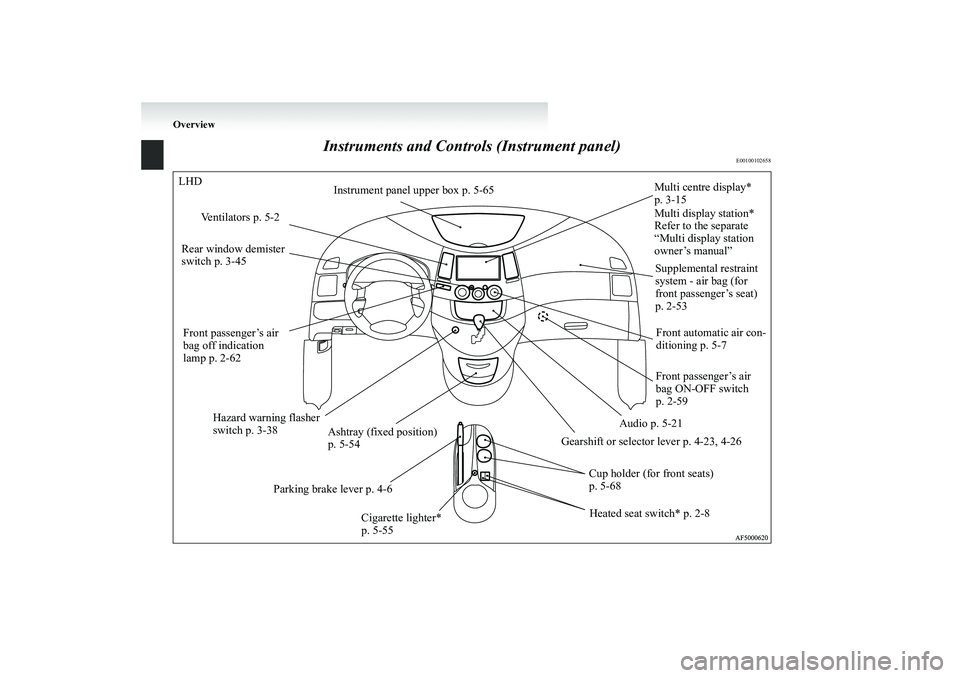
Overview
Instruments and Controls (Instrument panel)
E00100102658
LHD
Multi centre display*
p. 3-15
Ventilators p. 5-2
Rear window demister
switch p. 3-45
Hazard warning flasher
switch p. 3-38
Ashtray (fixed position)
p. 5-54
Cup holder (for front seats)
p. 5-68 Gearshift or selector lever p. 4-23, 4-26
Parking brake lever p. 4-6
Cigarette lighter*
p. 5-55Supplemental restraint
system - air bag (for
front passenger’s seat)
p. 2-53
Front automatic air con-
ditioning p. 5-7
Audio p. 5-21 Instrument panel upper box p. 5-65
Heated seat switch* p. 2-8Front passenger’s air
bag ON-OFF switch
p. 2-59 Front passenger’s air
bag off indication
lamp p. 2-62Multi display station*
Refer to the separate
“Multi display station
owner’s manual”BK-XP08E1ENUK.en-uk.book Page 3 Monday, August 13, 2007 2:20 PM
Page 7 of 458
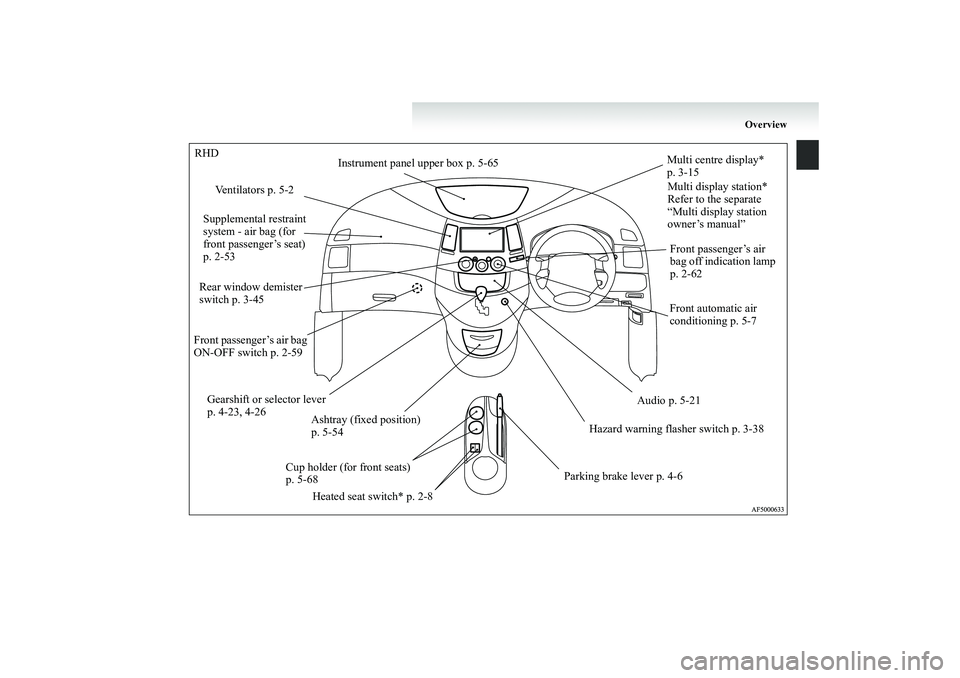
Overview
RHD
Instrument panel upper box p. 5-65
Ventilators p. 5-2
Supplemental restraint
system - air bag (for
front passenger’s seat)
p. 2-53
Rear window demister
switch p. 3-45
Front passenger’s air bag
ON-OFF switch p. 2-59
Gearshift or selector lever
p. 4-23, 4-26
Ashtray (fixed position)
p. 5-54
Cup holder (for front seats)
p. 5-68
Heated seat switch* p. 2-8Hazard warning flasher switch p. 3-38
Parking brake lever p. 4-6Front automatic air
conditioning p. 5-7
Audio p. 5-21Multi centre display*
p. 3-15
Front passenger’s air
bag off indication lamp
p. 2-62 Multi display station*
Refer to the separate
“Multi display station
owner’s manual”
BK-XP08E1ENUK.en-uk.book Page 4 Monday, August 13, 2007 2:20 PM
Page 136 of 458
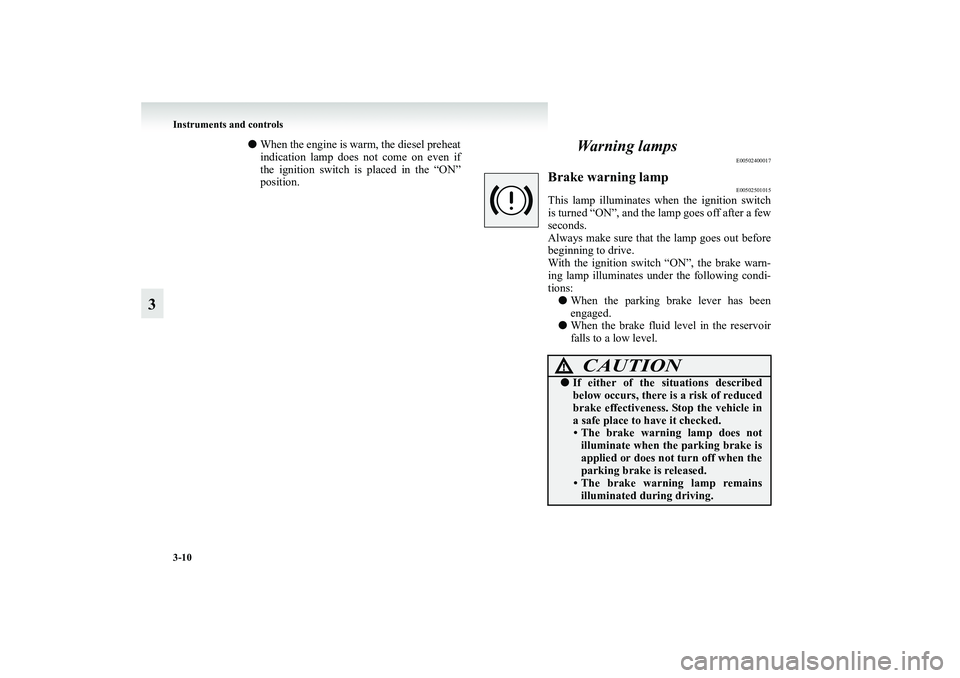
3-10 Instruments and controls
3
●When the engine is warm, the diesel preheat
indication lamp does not come on even if
the ignition switch is placed in the “ON”
position.
Warning lamps
E00502400017
Brake warning lamp
E00502501015
This lamp illuminates when the ignition switch
is turned “ON”, and the lamp goes off after a few
seconds.
Always make sure that the lamp goes out before
beginning to drive.
With the ignition switch “ON”, the brake warn-
ing lamp illuminates under the following condi-
tions:
●When the parking brake lever has been
engaged.
●When the brake fluid level in the reservoir
falls to a low level.
CAUTION
!●If either of the situations described
below occurs, there is a risk of reduced
brake effectiveness. Stop the vehicle in
a safe place to have it checked.
• The brake warning lamp does not
illuminate when the parking brake is
applied or does not turn off when the
parking brake is released.
• The brake warning lamp remains
illuminated during driving.
BK-XP08E1ENUK.en-uk.book Page 10 Monday, August 13, 2007 2:20 PM
Page 137 of 458
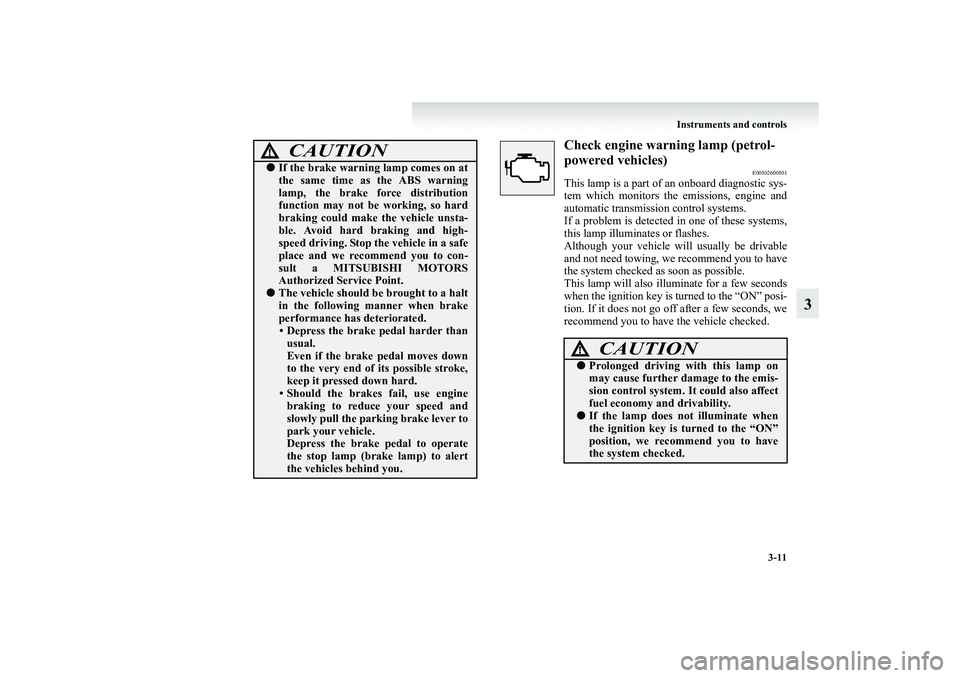
Instruments and controls
3-11
3
Check engine warning lamp (petrol-
powered vehicles)
E00502600501
This lamp is a part of an onboard diagnostic sys-
tem which monitors the emissions, engine and
automatic transmission control systems.
If a problem is detected in one of these systems,
this lamp illuminates or flashes.
Although your vehicle will usually be drivable
and not need towing, we recommend you to have
the system checked as soon as possible.
This lamp will also illuminate for a few seconds
when the ignition key is turned to the “ON” posi-
tion. If it does not go off after a few seconds, we
recommend you to have the vehicle checked.
●If the brake warning lamp comes on at
the same time as the ABS warning
lamp, the brake force distribution
function may not be working, so hard
braking could make the vehicle unsta-
ble. Avoid hard braking and high-
speed driving. Stop the vehicle in a safe
place and we recommend you to con-
sult a MITSUBISHI MOTORS
Authorized Service Point.●The vehicle should be brought to a halt
in the following manner when brake
performance has deteriorated.
• Depress the brake pedal harder than
usual.
Even if the brake pedal moves down
to the very end of its possible stroke,
keep it pressed down hard.
• Should the brakes fail, use engine
braking to reduce your speed and
slowly pull the parking brake lever to
park your vehicle.
Depress the brake pedal to operate
the stop lamp (brake lamp) to alert
the vehicles behind you.CAUTION
!
CAUTION
!●Prolonged driving with this lamp on
may cause further damage to the emis-
sion control system. It could also affect
fuel economy and drivability.●If the lamp does not illuminate when
the ignition key is turned to the “ON”
position, we recommend you to have
the system checked.
BK-XP08E1ENUK.en-uk.book Page 11 Monday, August 13, 2007 2:20 PM
Page 173 of 458
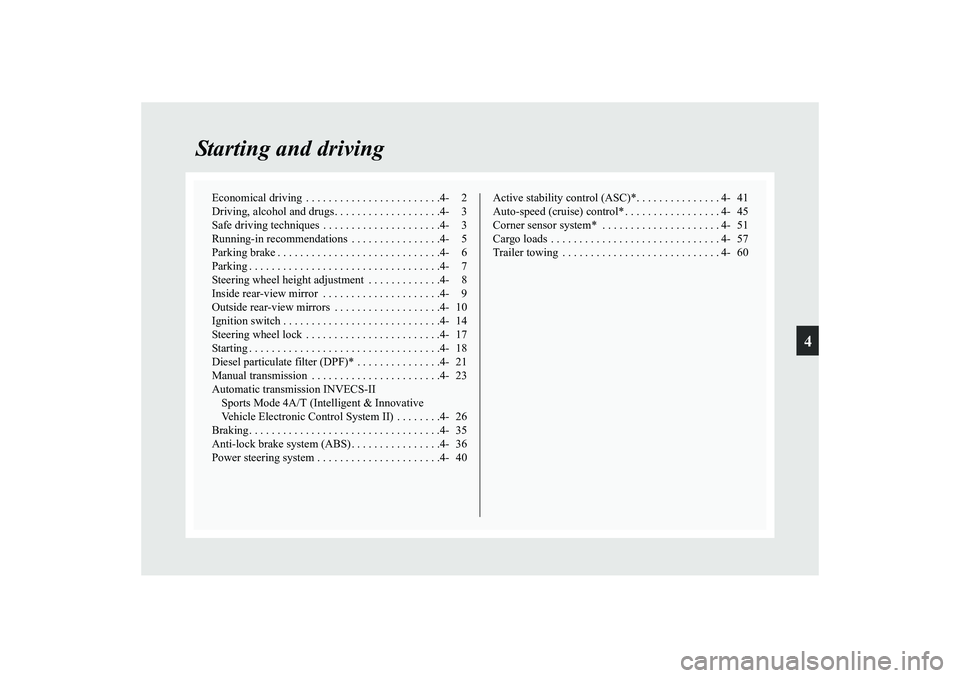
4
Starting and driving
Economical driving . . . . . . . . . . . . . . . . . . . . . . . .4- 2
Driving, alcohol and drugs. . . . . . . . . . . . . . . . . . .4- 3
Safe driving techniques . . . . . . . . . . . . . . . . . . . . .4- 3
Running-in recommendations . . . . . . . . . . . . . . . .4- 5
Parking brake . . . . . . . . . . . . . . . . . . . . . . . . . . . . .4- 6
Parking . . . . . . . . . . . . . . . . . . . . . . . . . . . . . . . . . .4- 7
Steering wheel height adjustment . . . . . . . . . . . . .4- 8
Inside rear-view mirror . . . . . . . . . . . . . . . . . . . . .4- 9
Outside rear-view mirrors . . . . . . . . . . . . . . . . . . .4- 10
Ignition switch . . . . . . . . . . . . . . . . . . . . . . . . . . . .4- 14
Steering wheel lock . . . . . . . . . . . . . . . . . . . . . . . .4- 17
Starting . . . . . . . . . . . . . . . . . . . . . . . . . . . . . . . . . .4- 18
Diesel particulate filter (DPF)* . . . . . . . . . . . . . . .4- 21
Manual transmission . . . . . . . . . . . . . . . . . . . . . . .4- 23
Automatic transmission INVECS-II
Sports Mode 4A/T (Intelligent & Innovative
Vehicle Electronic Control System II) . . . . . . . .4- 26
Braking. . . . . . . . . . . . . . . . . . . . . . . . . . . . . . . . . .4- 35
Anti-lock brake system (ABS) . . . . . . . . . . . . . . . .4- 36
Power steering system . . . . . . . . . . . . . . . . . . . . . .4- 40Active stability control (ASC)*. . . . . . . . . . . . . . . 4- 41
Auto-speed (cruise) control* . . . . . . . . . . . . . . . . . 4- 45
Corner sensor system* . . . . . . . . . . . . . . . . . . . . . 4- 51
Cargo loads . . . . . . . . . . . . . . . . . . . . . . . . . . . . . . 4- 57
Trailer towing . . . . . . . . . . . . . . . . . . . . . . . . . . . . 4- 60
BK-XP08E1ENUK.en-uk.book Page 1 Monday, August 13, 2007 2:20 PM
Page 178 of 458
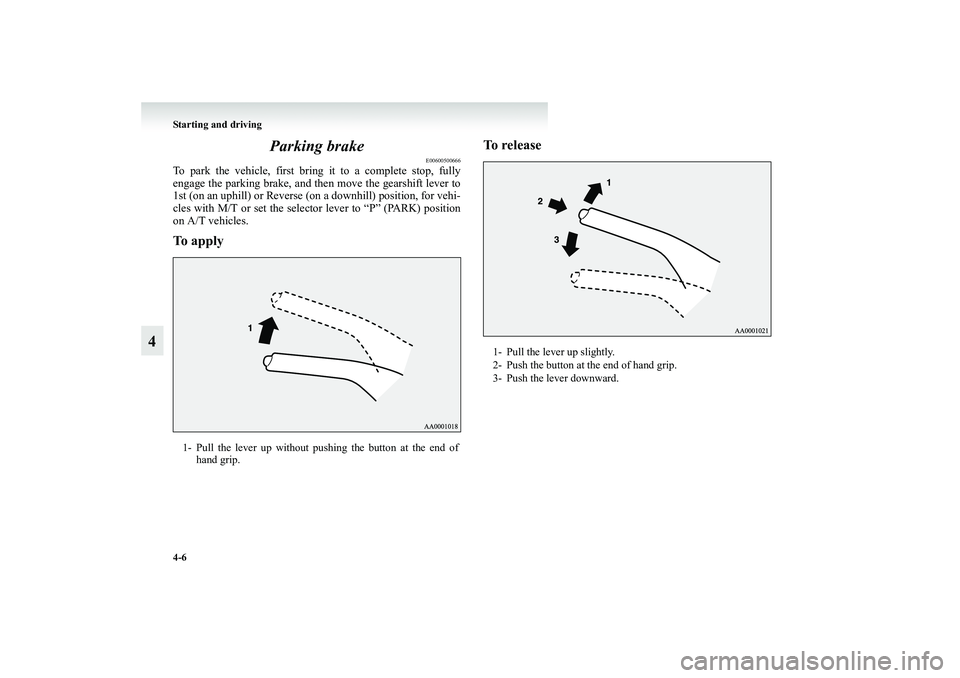
4-6 Starting and driving
4Parking brake
E00600500666
To park the vehicle, first bring it to a complete stop, fully
engage the parking brake, and then move the gearshift lever to
1st (on an uphill) or Reverse (on a downhill) position, for vehi-
cles with M/T or set the selector lever to “P” (PARK) position
on A/T vehicles.To applyTo release1- Pull the lever up without pushing the button at the end of
hand grip.
1- Pull the lever up slightly.
2- Push the button at the end of hand grip.
3- Push the lever downward.
BK-XP08E1ENUK.en-uk.book Page 6 Monday, August 13, 2007 2:20 PM
Page 179 of 458
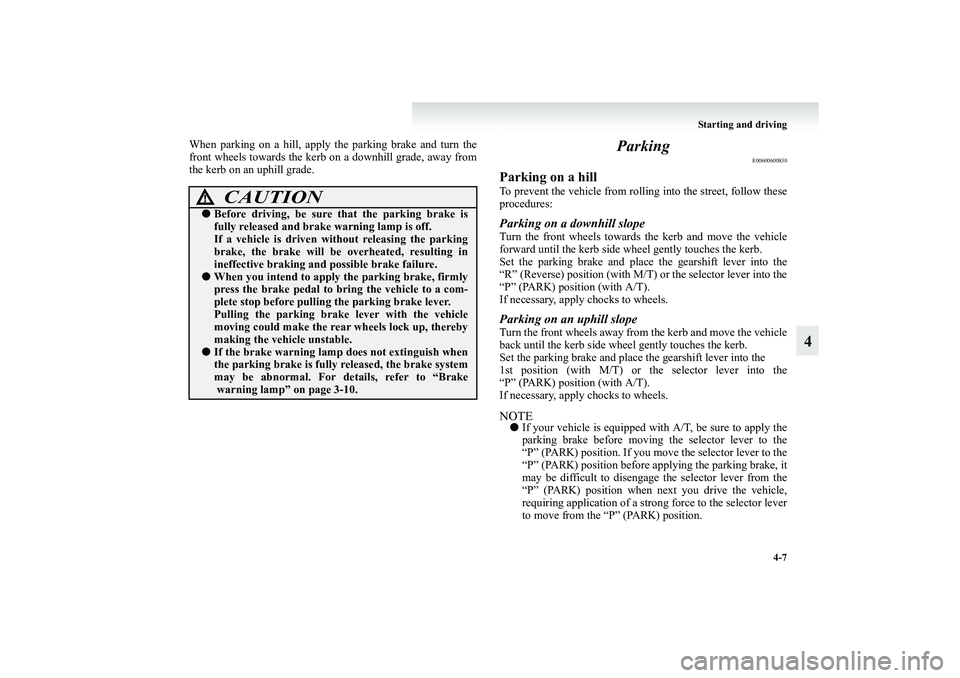
Starting and driving
4-7
4
When parking on a hill, apply the parking brake and turn the
front wheels towards the kerb on a downhill grade, away from
the kerb on an uphill grade.
Parking
E00600600830
Parking on a hillTo prevent the vehicle from rolling into the street, follow these
procedures:Parking on a downhill slopeTurn the front wheels towards the kerb and move the vehicle
forward until the kerb side wheel gently touches the kerb.
Set the parking brake and place the gearshift lever into the
“R” (Reverse) position (with M/T) or the selector lever into the
“P” (PARK) position (with A/T).
If necessary, apply chocks to wheels.Parking on an uphill slopeTurn the front wheels away from the kerb and move the vehicle
back until the kerb side wheel gently touches the kerb.
Set the parking brake and place the gearshift lever into the
1st position (with M/T) or the selector lever into the
“P” (PARK) position (with A/T).
If necessary, apply chocks to wheels.NOTE●If your vehicle is equipped with A/T, be sure to apply the
parking brake before moving the selector lever to the
“P” (PARK) position. If you move the selector lever to the
“P” (PARK) position before applying the parking brake, it
may be difficult to disengage the selector lever from the
“P” (PARK) position when next you drive the vehicle,
requiring application of a strong force to the selector lever
to move from the “P” (PARK) position.
CAUTION
!●Before driving, be sure that the parking brake is
fully released and brake warning lamp is off.
If a vehicle is driven without releasing the parking
brake, the brake will be overheated, resulting in
ineffective braking and possible brake failure.●When you intend to apply the parking brake, firmly
press the brake pedal to bring the vehicle to a com-
plete stop before pulling the parking brake lever.
Pulling the parking brake lever with the vehicle
moving could make the rear wheels lock up, thereby
making the vehicle unstable.●If the brake warning lamp does not extinguish when
the parking brake is fully released, the brake system
may be abnormal. For details, refer to “Brake
warning lamp” on page 3-10.
BK-XP08E1ENUK.en-uk.book Page 7 Monday, August 13, 2007 2:20 PM
Page 191 of 458
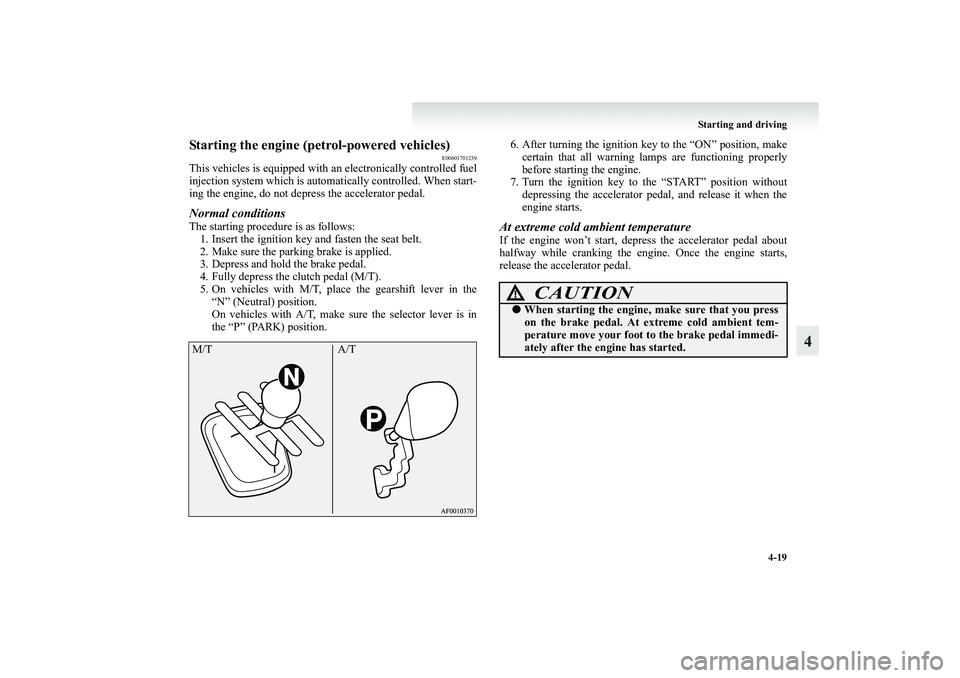
Starting and driving
4-19
4
Starting the engine (petrol-powered vehicles)
E00601701239
This vehicles is equipped with an electronically controlled fuel
injection system which is automatically controlled. When start-
ing the engine, do not depress the accelerator pedal.Normal conditionsThe starting procedure is as follows:
1. Insert the ignition key and fasten the seat belt.
2. Make sure the parking brake is applied.
3. Depress and hold the brake pedal.
4. Fully depress the clutch pedal (M/T).
5. On vehicles with M/T, place the gearshift lever in the
“N” (Neutral) position.
On vehicles with A/T, make sure the selector lever is in
the “P” (PARK) position.6. After turning the ignition key to the “ON” position, make
certain that all warning lamps are functioning properly
before starting the engine.
7. Turn the ignition key to the “START” position without
depressing the accelerator pedal, and release it when the
engine starts.
At extreme cold ambient temperatureIf the engine won’t start, depress the accelerator pedal about
halfway while cranking the engine. Once the engine starts,
release the accelerator pedal.
M/T A/T
CAUTION
!●When starting the engine, make sure that you press
on the brake pedal. At extreme cold ambient tem-
perature move your foot to the brake pedal immedi-
ately after the engine has started.
BK-XP08E1ENUK.en-uk.book Page 19 Monday, August 13, 2007 2:20 PM
Page 192 of 458
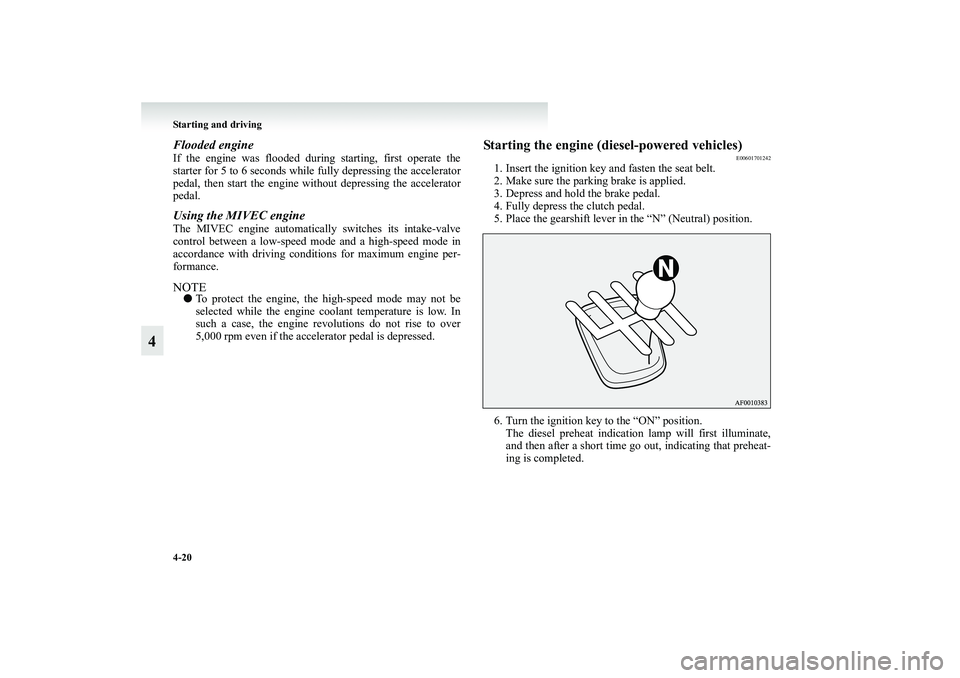
4-20 Starting and driving
4
Flooded engineIf the engine was flooded during starting, first operate the
starter for 5 to 6 seconds while fully depressing the accelerator
pedal, then start the engine without depressing the accelerator
pedal.Using the MIVEC engineThe MIVEC engine automatically switches its intake-valve
control between a low-speed mode and a high-speed mode in
accordance with driving conditions for maximum engine per-
formance.NOTE●To protect the engine, the high-speed mode may not be
selected while the engine coolant temperature is low. In
such a case, the engine revolutions do not rise to over
5,000 rpm even if the accelerator pedal is depressed.
Starting the engine (diesel-powered vehicles)
E00601701242
1. Insert the ignition key and fasten the seat belt.
2. Make sure the parking brake is applied.
3. Depress and hold the brake pedal.
4. Fully depress the clutch pedal.
5. Place the gearshift lever in the “N” (Neutral) position.
6. Turn the ignition key to the “ON” position.
The diesel preheat indication lamp will first illuminate,
and then after a short time go out, indicating that preheat-
ing is completed.
BK-XP08E1ENUK.en-uk.book Page 20 Monday, August 13, 2007 2:20 PM
Page 205 of 458
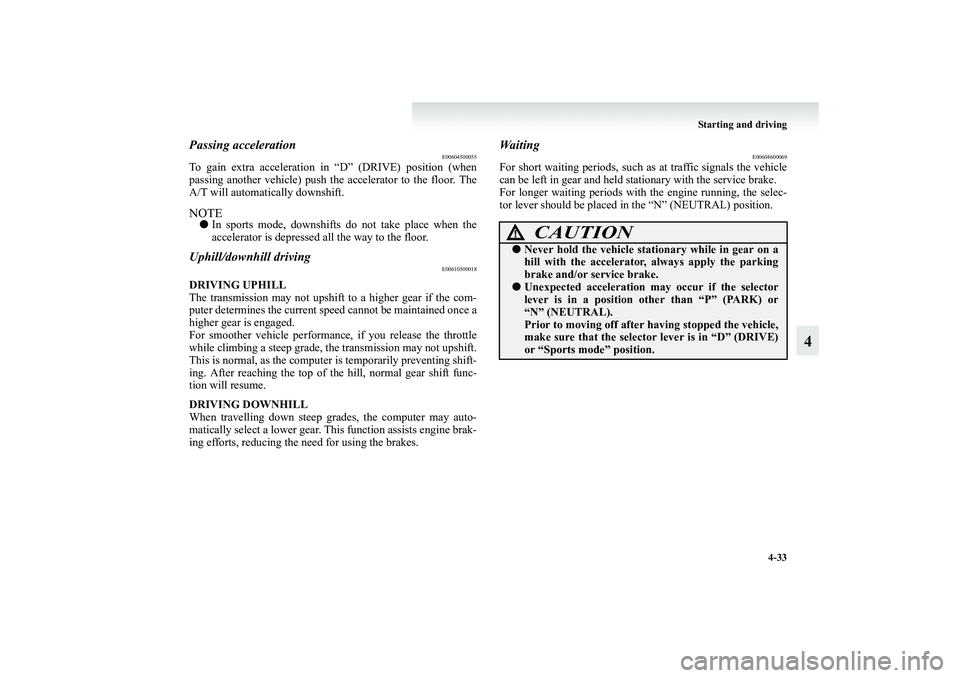
Starting and driving
4-33
4
Passing acceleration
E00604500055
To gain extra acceleration in “D” (DRIVE) position (when
passing another vehicle) push the accelerator to the floor. The
A/T will automatically downshift.NOTE●In sports mode, downshifts do not take place when the
accelerator is depressed all the way to the floor.Uphill/downhill driving
E00610500018
DRIVING UPHILL
The transmission may not upshift to a higher gear if the com-
puter determines the current speed cannot be maintained once a
higher gear is engaged.
For smoother vehicle performance, if you release the throttle
while climbing a steep grade, the transmission may not upshift.
This is normal, as the computer is temporarily preventing shift-
ing. After reaching the top of the hill, normal gear shift func-
tion will resume.
DRIVING DOWNHILL
When travelling down steep grades, the computer may auto-
matically select a lower gear. This function assists engine brak-
ing efforts, reducing the need for using the brakes.
Waiting
E00604600069
For short waiting periods, such as at traffic signals the vehicle
can be left in gear and held stationary with the service brake.
For longer waiting periods with the engine running, the selec-
tor lever should be placed in the “N” (NEUTRAL) position.
CAUTION
!●Never hold the vehicle stationary while in gear on a
hill with the accelerator, always apply the parking
brake and/or service brake.●Unexpected acceleration may occur if the selector
lever is in a position other than “P” (PARK) or
“N” (NEUTRAL).
Prior to moving off after having stopped the vehicle,
make sure that the selector lever is in “D” (DRIVE)
or “Sports mode” position.
BK-XP08E1ENUK.en-uk.book Page 33 Monday, August 13, 2007 2:20 PM